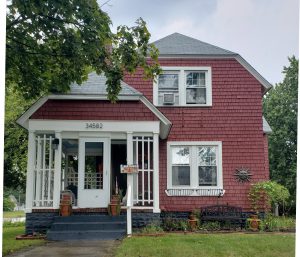A new kind of “house hunters” near you

Andrea Graham owns The Hathaway model from the Sears catalog of kit homes. This English cottage-style home in Wayne was built around 1928.
By Carolyn Marnon – Did you know there was a time when you could buy a kit through a catalog and then build your own home? Last September, Novi residents and kit home experts Andrew and Wendy Mutch came to the Wayne Historical Museum and spoke about their own kit house, a 1926 Sears Hamilton, the history of kit houses and an overview of some kit houses found here in Wayne.
Kit homes got their beginnings in the early 1900s in Bay City, Michigan. The Aladdin Company, owned by two brothers, Otto and William Sovereign, was one of the longest-lived manufacturers of mail-order, or kit, homes. Several years after the Sovereign’s introduced kit homes to the nation, Sears, Roebuck and Company and Montgomery Ward entered the market. Aladdin and Sears, the largest companies, sold thousands of kit homes per year in the 1920s. The 1930s brought decreased kit sales. The final Sears Modern Homes catalog came in 1940 and the last home kit was sold sometime around 1944.
A potential buyer of a kit home would find a postcard in a newspaper or magazine. The postcard would be mailed to the company requesting a catalog. The catalog would be mailed to the person who would then go through it and find their new home. They would send an order into the company noting any changes they might like to make, upgrades or additional items like windows, trims, furnaces. Once the company got the order, they would pack it into a railcar (or two, depending on home size) with all the components needed for the new owner to build their own home (or have someone build it for them.) It would be shipped to the closest railroad station to the owner. Once it arrived at the local station, the owner was notified that he would have 48 hours to come and unload the railcar. He would then take all the components to his land where he would have already, hopefully, put in the foundation for the home. A kit home saved a homeowner money and time. The instruction book that came with the kit might be 75 pages long, but at least the wood pieces were all pre-cut to size. The precut house with fitted pieces would take about 352 carpenter hours to build as opposed to 583 hours for a conventional house, a time reduction of 40%.
When the Mutch’s bought their home in 2003, the previous owner gave them a binder full of information about their house and about Sear’s kit homes in general. It wasn’t until about 2012 when they decided to investigate whether there were other “Hamilton” homes in their area. Their first discovery was another Hamilton in Ypsilanti found through a Sears archive of homeowners. The kit housing hunt was on. Since then, the Mutch’s have become a local authority on the subject, giving presentations at many of the library’s throughout Michigan.
Attendees of the presentation at the Wayne Historical Museum were able to ask questions and make comments. One attendee, Andrea Graham, pointed out that a red house in Wayne that appeared on screen during the Mutch’s presentation happened to be her house. She had purchased the home in 2005. She spoke to those gathered about the details that were put into the homes. She had discovered that not only was there wood trim framing the doorways of her closets, but she had stepped inside a closet one day to clean it out and discovered that the same attention to detail was used on the inside of the doors where people might not think to look.
Andrea’s home, the Sear’s Hathaway model, stands like a tall red sentry on the corner of Chestnut and Third. The open-air front porch that wraps slightly around the entrance corner has the original ornamental trellis detailing. This English cottage-style home, according to a page from a Sears, Roebuck and Co. catalog advertising the model “is a striking example of this style of architecture in frame construction and wood shingle siding. It makes a home suitable for suburb or country. The treatment is unique and artistic, the result being achieved at comparatively small cost. The ornamental trellised porch is a typical English feature. It is cozy and graceful and the colonial and French windows with their flower boxes make this type of house at home in any American community. The proud possessor will quickly avail himself of the special advantages which an artistic grouping of shrubs and flowers will secure. Vines or ivy on the trellis and side walls will transform this house into a bower of beauty.”
Andrea’s home was mentioned in Matt Miller’s column “Rearview Mirror” in the June 2009 issue of The Wayne Dispatch. Andrea was tickled because he called it “the most charming house on Chestnut.” This 3-bedroom, 1 bath home is thought to have been built around 1928. Andrea says some records say 1926, but the 3-bedroom model doesn’t show up in catalog information until 1928. It is thought the original home was owned by the brother of a former Wayne mayor; Andrea thinks she is the fourth owner.
“When I walked in here,” she says about the first time she saw the home, “it spoke to me. It had detail. It was charming. It had a fireplace, the wood floors. I had never seen anything like this before. It said Andrea all over it.”
The living room and dining room share an open-air concept. Plan drawings in the Sears catalog ad appear to show a wall dividing the two areas. Andrea thinks the builder never put up those walls. The original oak floors are in place. A previous owner had covered over the windows on the west side of the house with paneling; Andrea is not sure why because the now-uncovered windows let in plenty of light.
Although the basic layout of the kitchen and the woodwork and ornamental details are still in place, the kitchen was remodeled by a previous owner due to some perceived fire hazards. Andrea added new paint and retro-inspired tile. With her updates, she says she got her style while still paying homage to the original home. She points out the details she discovered inside the doors of the pantry closet. One couldn’t help but be surprised to see a window in the tiny closet that added natural light to the pantry.
Each step on the stairs leading to the upstairs bedrooms gave a long creeeeeak and moooooaaan. It was the kind of sound old-house lovers appreciate, a testament to the many years of use and the aging of the wood. The stairs and the floors on the upper level appear to be maple. Andrea says the more expensive wood was used where company might tend to gather while the less expensive wood would be installed in the more private areas of the home. At the top of the landing is a window with its original lead glass, called wavy glass by historic preservationists, that distorts the images outside of it. Some might be bothered by the waves, but others, like Andrea, find the charm. The bedroom doors are original to the house and have the original hardware knobs complete with skeleton keys.
Outside the house, Andrea points out the coal chute as part of the foundation that has since been sealed over. A nearby area of the foundation has wood covering it that Andrea says she has not removed to investigate what is behind it. The home now has energy-efficient windows, but the details around the windows have remained. When she bought the house, the side yard was fenced with chain link. She found it difficult to mow around, so she had the fence removed. All that remains is the stand-alone gate at the walkway. She said in the old days, homeowners would leave their gate open meaning they were accepting visitors. If the gate was closed, it meant they weren’t available. She chuckles when she recounts how someone passing by one day noticed the “fenceless” gate, smiled and whipped out his phone to take a picture.
According to John Mills, a member of the Wayne Historical Society and volunteer at the museum, 13 Sears model kit homes and 2 Montgomery Ward model kit homes (known as Wardway model homes) have been identified in the city of Wayne.
According to Andrew Mutch, “Most of the houses (in Wayne) were found by Wendy and I driving the streets of Wayne. When we spot possible houses, we note the address and take photos of them and comparing the possible houses to the models shown in the catalog. A few of them were found by other kit house researchers who did the same virtually using Google Streetview or who spotted possible kit houses in real estate ads. A group that I work with does maintain several databases for houses from different companies that have been identified and authenticated across the United States. I did reference those to see if there were any other houses in Wayne that we had missed. We also heard from several residents who reached out in advance of the program to let us know about potential houses.”
How can you tell if your home is a kit home? You can look at the style of the home paying special attention to the roofline and the chimney placement, and compare it to catalog photos. Also look at window arrangements, columns and eave brackets. Is the home near a railroad? (Remember the kits were delivered to the town via railway cars.) Talk to neighbors or others in your community who might know something about your home’s history. Check the county Register of Deeds to trace the chain of ownership of the home. You will need the legal property description which could be found on a property tax bill. You can even check for stamped lumber, fixtures and joiner trim blocks, copies of blueprints and shipping labels.
If you know that you live in a catalog kit home, Sears, Wardway, Aladdin, Sterling, or Lewis, please contact the museum. You can call (734) 722-0113, email waynehistoricalsociety@gmail.com or stop by the museum, 1 Towne Square.




